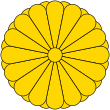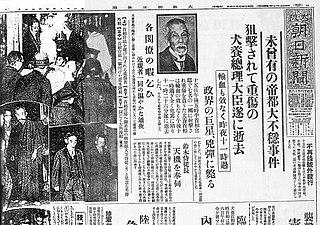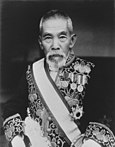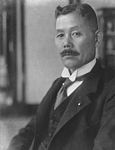
Viscount Takahashi Korekiyo was a Japanese politician who served as a member of the House of Peers, as the 20th Prime Minister of Japan from 13 November 1921 to 12 June 1922, and as the head of the Bank of Japan and Ministry of Finance.
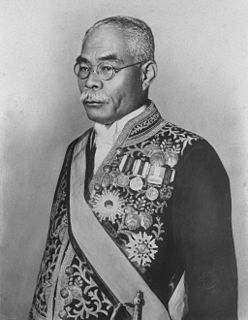
Hamaguchi Osachi was a Japanese politician, cabinet minister and Prime Minister of Japan from 2 July 1929 to 14 April 1931. Nicknamed the "Lion Prime Minister" due to his dignified demeanor and mane-like hair, Hamaguchi served as leading member of the liberal Rikken Minseitō during the "Taishō Democracy" of interwar Japan; he survived an assassination attempt by a right-wing fanatic in 1930, but died about eight months later.

The Taishō period, or Taishō era, is a period in the history of Japan dating from 30 July 1912, to 25 December 1926, coinciding with the reign of the Emperor Taishō. The new emperor was a sickly man, which prompted the shift in political power from the old oligarchic group of elder statesmen to the Imperial Diet of Japan and the democratic parties. Thus, the era is considered the time of the liberal movement known as the "Taishō democracy" in Japan; it is usually distinguished from the preceding chaotic Meiji period and the following militaristic-driven first part of the Shōwa period.
The political situation in Japan (1914–44) dealt with the realities of the two World Wars and their effect on Japanese national policy.
Political parties appeared in Japan after the Meiji Restoration, and gradually increased in importance after the promulgation of the Meiji Constitution and the creation of the Diet of Japan. During the Taishō period, parliamentary democracy based on party politics temporarily succeeded in Japan, but in the 1930s the political parties were eclipsed by the military, and were dissolved in the 1940s during World War II

General elections were held in Japan on 20 February 1928, the first after the introduction of universal male suffrage. The ruling Rikken Seiyūkai led by Prime Minister Tanaka Giichi won one more seat than the opposition Rikken Minseitō led by Hamaguchi Osachi, although Rikken Minseitō had received slightly more votes. The hung parliament led to the Tanaka government continuing in office.

Rikken Minseitō was one of the main political parties in pre-war Empire of Japan. It was commonly known as the 'Minseitō'.
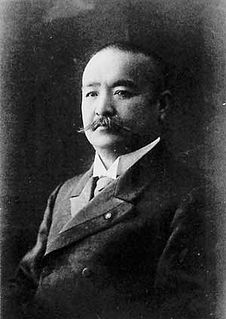
The Rikken-Dōshi Kai was a political party active in the Empire of Japan in the early years of the 20th century. It was also known as simply the Dōshikai.
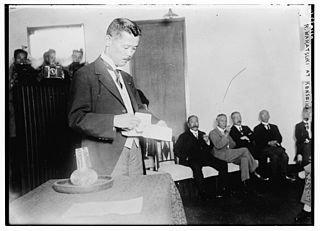
The Kenseikai was a short-lived political party in the pre-war Empire of Japan.

Fusanosuke Kuhara was an entrepreneur, politician and cabinet minister in the pre-war Empire of Japan.
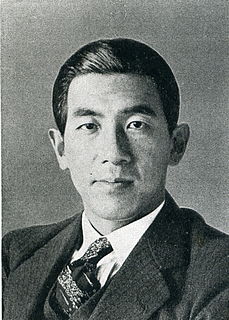
Takeru Inukai was a Japanese politician and novelist active in Shōwa period Japan. Also known as "Inukai Ken", he was the third son of Prime Minister of Japan Inukai Tsuyoshi.
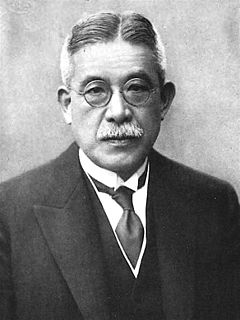
Takejirō Tokonami was a Japanese statesman, politician and cabinet minister in Taishō and early Shōwa period Japan. Tokonami was involved in several government agencies throughout his career, and served in the leadership of different political parties. He was regarded by his contemporaries as a rather opportunistic politician eager for an opportunity to become prime minister.

Yukio Sakurauchi was an entrepreneur, politician and cabinet minister in the pre-war Empire of Japan. He was the father of prominent post-war politician Yoshio Sakurauchi, and grandfather of controversial politician Seiichi Ota.

Suzuki Kisaburō was a statesman, politician and cabinet minister in Taishō and early Shōwa period Japan.
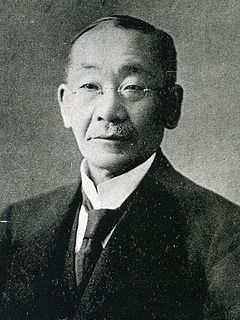
Machida Chūji was a politician and cabinet minister in the pre-war Empire of Japan.
The Seiyūhontō was a political party in Japan. It was active from 1924 until 1927.
The Kakushin Club was a political party in Japan.
